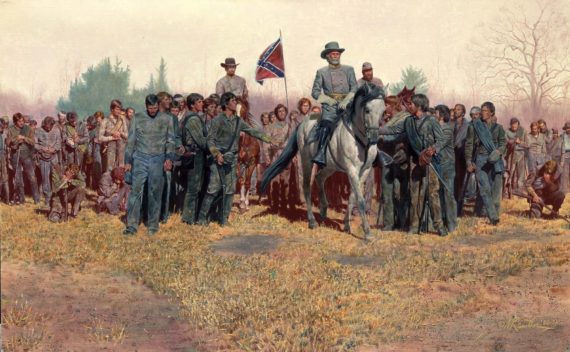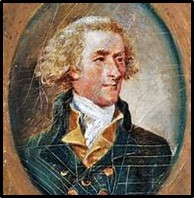This piece was originally printed at res33blog.com.
The commentary by University of North Carolina-Wilmington history Professor Chris E. Fonvielle Jr. titled, “Why the Civil War still matters” published in the Wilmington StarNews last March caught my attention both for his review of some interesting facts, and his omissions and conflicting ideas about that historic period. Prof. Fonvielle explains some of the reasons North Carolina “held events to commemorate the great watershed event in American history” during the past sesquicentennial period. He begins by saying the War ended 150 years ago, “but in many ways it is still with us.”
He is right about that. The United States were forever torn apart by that needless and destructive period thrust upon the Southern people. As Christians they might forgive, but they can’t forget—nor should they—the utter devastation and poverty imposed on them by Lincoln’s war and the hordes of Northern opportunists who descended like locusts to swarm around their culture and devour their property.
First, Dr. Fonvielle gives credit to State agencies and historic locations where “living history encampments, battle re-enactments and presentations by historians attracted thousands of people.” He notes that the North Carolina Office of Archives and History created a website “documenting the war in the state.” Yet he ignores the many encampments, re-enactments, living histories and scholarly presentations given throughout the State by private North Carolina citizens, such as the Sons of Confederate Veterans, the United Daughters of the Confederacy, native State re-enactors and local historians.
It’s understandable that as a State employee Fonvielle would promote the government programs, but bureaucrats often infuse political agenda into history that tends to obscure a more complete account, and distort or omit uncomfortable truths. Worse, some government-sponsored accounts actually revise history by referring to events in modern context. This “presentism” approach flaws writings about the past, especially politically-charged events.
For example, I’m told, the North Carolina OAH never offered “technical, professional and financial” assistance to the private projects of an important private sesquicentennial commission organized in this State.
Prof. Fonvielle made no mention in his article of this marvelous source for understanding the War from North Carolinians who experienced it. Both the State website he mentions and his article conspicuously omit the most important information key to the conflict from a North Carolina viewpoint: “why North Carolinians chose independence; the men who fought the Northern invasion, and the privations and suffering brought upon the civilian citizens of this State.”
That website presented by the North Carolina War Between the States Sesquicentennial Commission has been running since 2011—promoted widely in brochures and personal presentations. The Commission also sponsored numerous lectures, tours, re-enactments and living history events explaining the war from the viewpoint of the North Carolinians who fought, sacrificed and died for their homeland. This site (and associated events) operates privately without taxpayers’ subsidy.
Fonvielle correctly notes that “Southerners take a greater interest in Civil War history in part because most of the battles were fought in the region, which led to a wilderness of devastation and destruction by war’s end”—but, we must add, not of their making. North Carolina was one of the last States to withdraw from the Union with the Northern States. It did so only after Lincoln’s demand for North Carolina troops to help subjugate South Carolina. Gov. John W. Ellis refused the call:
On 1 May [1861, Governor John W. Ellis] addressed the opening session of the General Assembly. Declaring that “the right now asserted by the constituted authorities of that government [in Washington], to use military force for the purpose of coercing a State to remain in the Union against its will, finds no warrant in the Constitution,”
Ellis proceeded to demonstrate that neither the Declaration of Independence nor the Constitution gave or intended to give such authority to the central government.
Fonvielle also writes: the “South underwent a painful and often violent transformation…to a fully integrated society”—again, imposed on the South by vengeful Northern politicians. But it’s not true that this brought a “fully integrated society.” During “Reconstruction” recently freed slaves with no understanding of government were placed in political offices in Southern States under martial law—while Northern Negroes held mostly servant positions—and “carpet bagging” Yankees came to exploit the Southern people. Those damages and insults forever poisoned the well of union between the Northern and Southern States and resulted in myths about this historically tragic period.
The North was a deeply segregated society; no free Negroes were welcome to compete for jobs; and “black codes” (Jim Crow) originated in Northern States. In Connecticut it was unlawful to educate black children; there were laws against Negro assemblies; codes prohibited black immigrants from slave states; typically, Indiana and Ohio prevented free blacks from entering the State or owning property. An 1853 law in Illinois, Lincoln’s home State, barred Negroes from living in the State. It had the most severe anti-Negro measures passed in any “free-state,” and Lincoln never spoke out against it.
Charles Adams an American historian wrote: “Free blacks (in Northern States) were shunned with much more pertinacity than in the South where blacks mixed more freely with whites.” The Frenchman, De Tocqueville, who traveled extensively and studied American society observed in 1830: Southern people were “much more tolerant and compassionate” toward blacks than were Northerners.
Self-righteous critics of Southerners have no standing based on assigning current moral purity to their ancestors. Nothing about the myth of a “fully integrated society” has validity. To this day, despite all the “civil rights” hype, we have a volatile segregated society; witness the urban riots by blacks that still plague us—much of it in Northern cities.
I also take issue with Fonvielle’s musing about an “indivisible nation.” We are more divided now than ever because of the Leviathan growth of the federal government since the WBTS and cultural revolutions in the 1960s that have destroyed American traditions. The size of the United States as now composed makes it ungovernable. In my opinion, the South remains the only region in America with a vestige of cultural continuity.
Fonvielle writes that the “most ringing phrase” in the Declaration of Independence is “All men are created equal.” In that same paragraph it was also self-evident to the patriot authors:
“That whenever any Form of Government becomes destructive of these ends (Life, Liberty and the pursuit of Happiness) it is the Right of the People to alter or to abolish it, and to institute new Government.”







